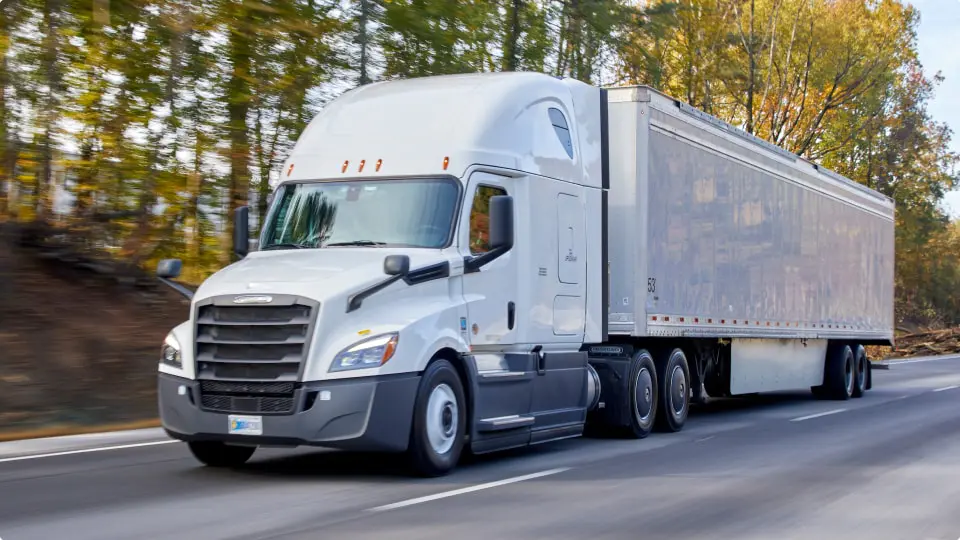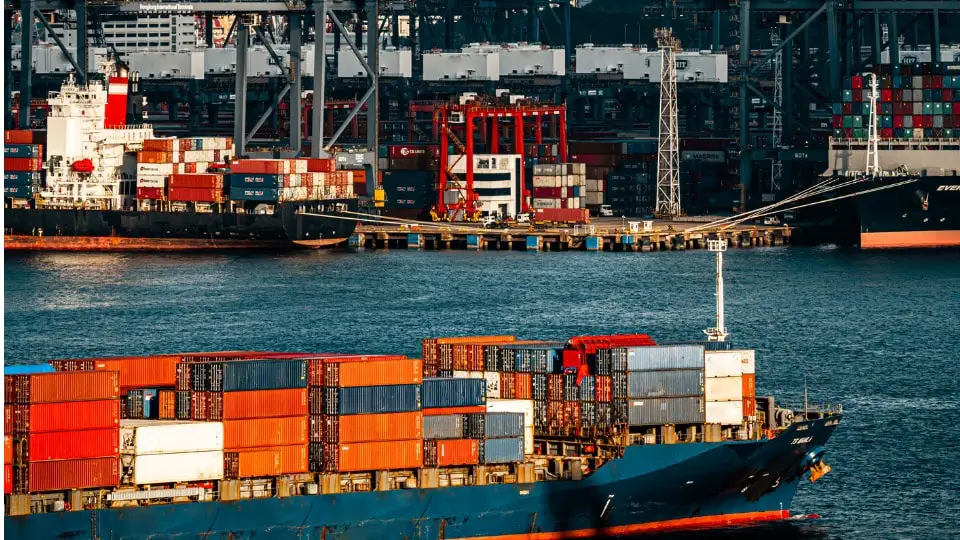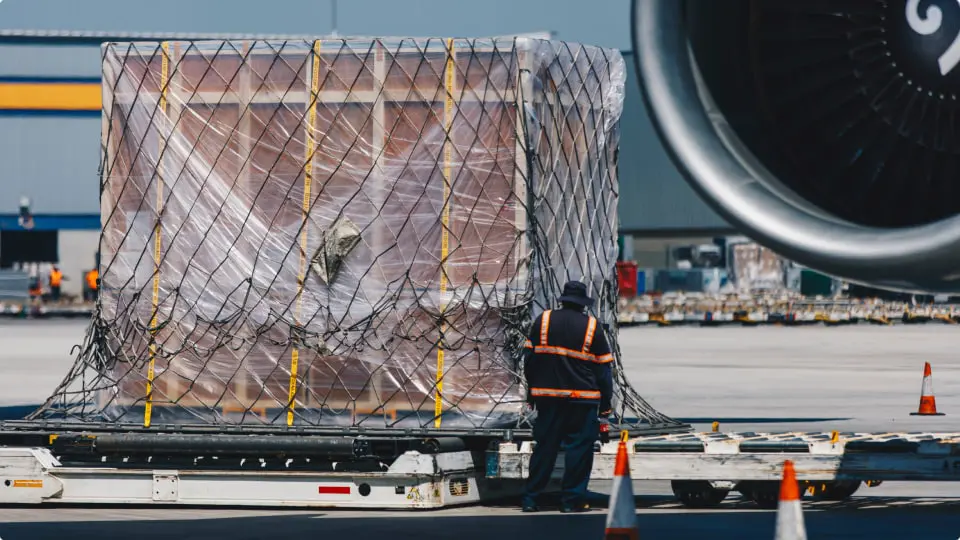*Offer valid on Freight, Fuel Surcharge and Security Surcharges only from July 20 through August 31 (both dates inclusive). See additional Terms and Conditions.
This Guide Contains:
What is Freight Shipping?
Here’s the simplest freight definition: freight shipping—or freight transportation—is the process of moving goods, commodities and cargo in bulk from one point to another, almost anywhere in the world. Freight shipping options include air, ocean, ground and rail shipping or intermodal, which is a combination of these modes.
Freight vs. Shipping Small Package
What’s the difference between packages and freight? The simple difference is weight. If your shipment is 150 pounds or less, it’s considered small package. If your shipment is larger than 150 pounds and up to 15,000 pounds, it’s considered freight. If you’re still not sure, consider this: if you just have a few parcels, traditional small-package transportation is probably just fine. But, if you have a large shipment with a large quantity of goods, we recommend freight transportation.
Freight shipping is ideal for a vast array of goods and there's really no limit to what can be shipped via freight.
How Do I Select the Right Mode of Transportation?
With so many types of freight shipping, how do you know which is best for your situation? And, how fast is freight shipping? While there are other important considerations, which we’ll discuss shortly, your primary decision-drivers are usually urgency and cost.
If your top concern is, “How fast can I move freight,” air freight is likely the best place to begin. Air freight is the fastest option, but also the most expensive. For example, we can help get your shipment on a Next Flight Out with delivery from ‘as soon as possible’ to three days later.
If your top concern is, “How much does it cost to move freight,” ocean freight is likely your best option. While it’s the slowest option, ocean freight is also the most budget-friendly option, an important considerations when you’re trying to conserve cost.
What Are the Other Key Considerations When Shipping Freight?
Shipment Type
The size, weight and nature of your goods may also impact the choice of shipping mode. Heavy or oversized goods are likely best suited for ocean freight when travelling internationally and road or rail freight when being transported domestically. Temperature-controlled items, such as pharmaceuticals and medical products and perishable items, like wine, meats or fresh fruits likely require special packaging and handling and are probably best moved by air freight shipments.
Carrier Reliability
Price shopping is important but choosing the cheapest carrier may not be the most prudent choice in the long run. Always research the reliability of your carrier(s) before making a decision. Supply chains can be disrupted by port congestions and closures, labor shortages, containers and space shortages and capacity issues. Make sure your ocean freight carrier has access to the equipment and space to keep the booking promises they make. And always choose reliable air carriers who will be able to load your shipment on a booked flight, not a series of partial shipments.
Safety
Ensuring the integrity and safety of your goods is important. Know your goods—and your customer’s expectations—and choose accordingly. Goods traveling via ocean or rail transport are more prone to damage or loss. Air and land transport is safest for shipping fragile or perishable goods. As mentioned above, always be aware of the reliability record of your chosen carrier.
Choosing the right mode of transportation can reduce logistics costs, mitigate delays, improve customer experience and generally optimize your supply chain.
How Does Freight Travel?
Freight travels by air, ocean, ground, rail or a combination of multiple modes.
| Mode | Air Freight | Ocean Freight | Ground Freight | Rail Freight | Multimodal |
|---|---|---|---|---|---|
| Definition | Generally, one of fastest and most expensive types of freight transportation. Air freight is typically used for time-sensitive goods that are high-value and lightweight. (Can be cost prohibitive for low-value, commodity products or goods that are bulky or heavy.) | Ocean freight is transported by ship, in large containers. It is the slowest, but most affordable freight option. In addition to traditional ocean passage, water carriage also includes inland and inter-coastal waterways, such as rivers, canals and lakes. | Also known as truck, highway or road transportation, ground freight is a less expensive transportation option to ship large, non-time-sensitive cargo by truck. Delivery can take 3–10 days, depending on pickup and delivery locations. | The process of moving cargo by utilizing trains and railroads. This is ideal for raw materials or moving ocean containers across long distances. | Combining more than one mode of transportation to provide a unique solution that can be cheaper than air freight, but faster than ocean freight. |
| Advantages |
|
|
|
|
|
| Types |
|
|
|
N/A |
|
What is a Freight Forwarder?
A freight forwarder is a company that specializes in helping shippers (often called consignees) arrange for the importing and exporting of their goods. The freight forwarder itself does not actually move your freight, but acts as an intermediary between you and the various transportation carriers you can utilize (i.e. air, ocean, road, rail and/or intermodal).
Freight forwarders have established relationships with carriers, enabling them to recommend the best balance of speed, cost and reliability when moving your goods. They also handle the considerable and sometimes complex, logistics of transporting goods across borders. A good forwarder has extensive knowledge of Customs documentation requirements, country codes and regulations, transportation costs and international banking practices.
What are freight services they can provide:
- Preparation of shipping and export documents
- Booking cargo space
- Negotiating freight charges
- Storage and warehousing
- Tracking transportation
- Freight consolidation/deconsolidation
- Assistance with cargo insurance
How Do I Know if I Need a Freight Forwarder?
The complex processes, paperwork and regulations required for international trade can be intimidating to those unfamiliar with them. This is where a freight forwarder can be an invaluable asset.
Regardless the size of your company or the type of goods you ship, a good freight forwarder will be an end-to-end provider who leads your cargo from origin to destination. It’s their job to know the shipping companies, documentation procedures and customs laws of various countries.
Though a freight forwarder is not required for importing or exporting goods, they can be tremendously valuable to companies dealing in the international transportation of goods. They can be especially helpful if your in-house resources are not as informed on international shipping procedures.
Freight forwarders typically charge modest rates for their services, but also have access to shipping discounts. Bottom line: choosing the right freight forwarding provider can save you untold time, eliminate considerable headaches and provide a reliable transportation experience for you and your goods.
Looking for a Forwarder That Can Understand Your Unique Business?
UPS Supply Chain Solutions is one of the world’s largest providers of transportation, logistics and freight forwarding services. But that doesn’t mean we only keep company with companies our size. On the contrary, the vast majority of our customers are far from intergalactic enterprises. And each of them — regardless of size — can take advantage of our global expertise, brand stability and leading-edge compliance and technology capabilities. Whether by air, ocean, road or rail, we’ll get it there for you.
How Do I Ship Freight?

1. Choose a Transportation Mode
Decide which transportation mode is best for your timeline, budget and specific needs. You can get and compare air and ocean freight quotes using the UPS® Forwarding Hub.
2. Fill Out the Forms
Freight can’t be picked up without proper documentation, so gather and fill out the necessary shipping documents. Learn more about shipping documents.

3. Pack Your Freight
Determine the best packing options and materials to secure and protect your shipment and mitigate damage. You can choose from a variety of packaging materials, such as paper, foam or bubble wrap padding, loose packing, edge boards, corrosion protection and shrink wrapping. If you’re shipment will be palletized, decide if you’ll use plastic or wooden pallets. Depending on the destination, determine if the wooden pallets need to be heat treated.
4. Schedule a Pickup
If you’re scheduling your own pick-up, it’s a good idea to book the pickup several days in advance of your needed pickup date. Determine if you or your recipient will require a liftgate, in the event either of you don’t have a loading dock. Contact the carrier’s local service center. If you’re using UPS, you can schedule your pickup through the UPS® Forwarding Hub, where you’ll also receive your cost estimate and tracking number.

5. Your Shipment is Transported
If you have a tracking number, you can keep track of your shipment or if available, be alerted at key milestones or if any exceptions occur. Your shipment is transported to the local service center. If it’s going by air, it’s taken to a local hub or directly to the airport. If it’s going by ocean, it’s transported to the nearest port and loaded on an ocean vessel.
6. Clearing Customs
When your shipment arrives at the destination air gateway or port, it is processed for Customs clearance, which can take up to three days. If the shipment clears Customs before 9 a.m. that day, it can be loaded onto a truck to be driven to its final delivery destination. Your shipment only has to clear customs in the country of its final destination.
What Factors Impact Freight Shipping Rates?
When all things are equal, freight prices are determined by several factors:

Type of Cargo
The type of goods, weight and density all impact the freight shipping class, which impacts freight cost. So, what is freight classification? It is the standardized shipping industry pricing classification that establishes uniform parameters for commerce between multiple brokers, warehouses and carriers. Class is determined based upon a range of factors, including: ease of handling, value, weight, length, height, density and liability. Put simply, the bigger the cargo, the more room needed for transport. Regardless of transportation mode, the size of the goods—and the manpower needed to move it—will determine how much you pay.
Urgency
How quickly you need your goods to be delivered impacts both shipping mode and cost. With more advance planning and logistics flexibility, you can improve efficiency, optimize routes and modes and save you money. But, in the most urgent situations, you may need to turn to next-day or even same-day options.
Mode of Transportation
Generally, air freight shipping is going to be the most expensive shipping option, while ocean freight is going to be the least expensive shipping option. Also, look for unique intermodal freight shipping options that might be just right when air freight is too expensive and ocean freight is too slow.
Distance
Generally, the greater the distance between the original pick-up point and final destination, the higher the shipping cost. But additional factors like geographic location, complexity of pick-up/delivery and fluctuating fuel costs can also be factors. An experienced 3PL can help you develop supply chain strategies to help cut freight costs and maximize your transportation budget.
Unexpected Disruptions
Unforeseen disruptions like port closings, labor and equipment shortages, labor issues and fuel shortages, not mention weather strikes, can all create capacity issues and budgeting obstacles that can increase freight rates with little notice.
Seasonality
Seasonal trends can have a significant impact on freight costs. With more demand comes higher cost. At times when transportation becomes a higher priority, rates increase. To avoid seasonal surprises and blowing your freight budget, it’s critical to have timely and accurate business forecasting.
What Freight Documentation Do I Need?
There are several key documents used in the international shipping process. They define the shipping transaction and provide information for Customs and regulatory compliance. You can fill these documents out in the UPS Forwarding Hub.
Bill of Lading (B/L) - The forwarder/NVOCC will provide this document to the shipper.
Establishes the terms of the contract between the shipper and the transportation company. It serves as a document of title, a contract of carriage and a receipt for goods.
- House Air Waybill (HAWB) — A freight forwarder’s waybill that identifies a single shipment.
- Master Air Waybill (MAWB) — An airline’s waybill that may be used for the consolidation of several house air waybills.
- Sea Waybill - A NVOCC's waybill that acts as a contract of carriage and a receipt of goods. Unlike a Bill of Lading, a Sea Waybill does not serve as a document of title.
Commercial Invoice - The shipper is responsible for providing this document to the forwarder.
Contains information about the commercial transaction between the shipper and consignee/receiver, typically with these characteristics:
- Printed on company letterhead
- Full details of shipper, consignee, intermediate consignee, etc.
- Reference numbers (Invoice, Purchase Order, etc.)
- Date
- Description, quantity and value of goods
- Original signature in blue ink
- Used to determine duties and taxes
- Used by exporter in processing original terms of sale or when quoting pricing
Shipper's Letter of Instruction (SLI) - The shipper is responsible for providing this document to the forwarder.
A letter from the shipper instructing the shipping company how the shipper wants the shipment handled, typically containing:
- Detailed shipper and consignee identification
- Air waybill or tracking number
- Service requested
- Key reference numbers
- Payment terms
- Commercial shipment value
- Insurance coverage requested
- Limited export power of attorney
Electronic Export Information (EEI) - The forwarder can provide this document if the shipper requests it. The forwarder needs to have the shipper's POA on file in order to act on their behalf.
Previously known as the Shipper’s Export Declaration (SED), this filing is generally required by the US Census Bureau for US exports containing a single commodity with a value exceeding US$2,500. EEI is also required for shipments of items on the US Commerce Control List to military end use countries. EEI information is provided to the US Census Bureau and is used for export compliance and governmental reporting. It provides the following information:
- Trade information
- Commodity identification using the Schedule B number
- Employer Identification Number (EIN)
- Signature of exporter or representative with power of attorney
- Information about export licenses that might apply
Certificate of Origin - The shipper is responsible for providing this document to the forwarder . The forwarder can also prepare this document for the shipper as long as the shipper gives the proper information to the forwarder.
Defines the origin of the goods being shipped. It is not required for all shipments, only those going to specific countries that require it for Customs clearance or when it is specifically required in the terms of the transaction. It:
- Attests to the origin of where the goods were manufactured
- Requires full details of shipper, consignee, description, pieces, weight, markings and mode of transport
- Is stamped by the Chamber of Commerce and signed by a notary public
- May allow favorable duty rates
*Israel has its own Certificate of Origin
Hazardous Materials/ Dangerous Goods (HAZMAT) - The shipper is responsible for providing this document to the forwarder.
Extra documentation is required for articles or substances that can pose a risk to health, safety, property or the environment and are shown on the list of dangerous goods in the Dangerous Goods Regulations. Shipment of dangerous goods by air is highly regulated. Specific processes and procedures must be followed for documentation, package marking and labeling, as well as shipment handling
What is Customs Clearance?
When international shipments enter the importing country, they must be cleared by that country’s Customs authorities before they can be delivered to their final destination. Customs clearance is the act of moving goods through the Customs process.
In addition, every country imposes import duties and taxes on the goods that cross their borders. This helps to generate income, while also protecting their economy, their environment and their citizens.
For those unaccustomed, this can seem like a complex, sometimes confusing, process. But managed properly, it doesn’t have to be complicated. Here’s what happens when a shipment arrives at Customs:

Customs officers examine the required paperwork
To avoid Customs holds or delays, it’s important that all necessary forms be accurate and complete, especially the shipping label and commercial invoice.
Import duties and taxes are assessed
Import fees vary based on the type of goods, their value and any unique regulations in the receiving country. Import duties are assessed on goods that exceed the minimum taxable threshold for imported goods. Goods valued under that threshold incur no import duties.
Customs requests payment for applicable duties and taxes
If your shipment exceeds the tax threshold, the customs officer checks to see if duties and taxes have been paid. Additionally, certain restricted goods may incur fees regardless of their value. The shipper/consignee should determine in advance how these fees will be paid.
- Delivery Duty Paid (DDP) — This means import duties and taxes have already been paid. When choosing DDP, the price you paid for shipping covers any import fees, which is reflected on the attached shipping label. This is the best, most recommended way to ensure a smooth customs clearance process.
- Delivery Duty Unpaid (DDU) — This means import duties and taxes are not included in the price of the shipping. In this instance, the customs officer forwards the shipment to an independent customs broker to collect the required fees. These fees can become more expensive, with additional variable charges for brokerage, storage and possibly late payment. In addition, the broker will contact the recipient to collect payment, which may be surprising or upsetting to customers.
Your shipment clears customs
Once all duties are paid and clearance is complete, your shipment can be transported from Customs to its final destination. With thorough attention to detail in filling out forms and paperwork, shipments rarely get stuck at customs.
Should I Insure my Freight Shipment?
It’s important to understand the difference between carrier liability coverage and cargo insurance. Though they sound similar, there are significant differences between the two. Understanding the difference can help you reduce risk and lower shipping costs.
Simply put, the main differences define what’s covered/not covered and who’s considered at fault when something goes wrong.

Carrier Liability
Carrier Liability is generally included in the shipping quote from the carrier. Coverage may depend on what you’re shipping and the carrier’s rate for that type of goods and is often much less than the real value of your cargo.
- What’s covered/not covered? Carrier liability does not cover concealed damage, weather, acts of God or damage resulting from improper packaging or loading. Read the fine print on any carrier liability agreement.
- Who’s at fault? With carrier liability, the shipper must prove that the damage or loss is the carrier’s fault and provide evidence of value and loss.
Cargo Insurance
Cargo Insurance is elective coverage (meaning you can purchase it or not) based on the actual value of your cargo. Generally, cargo insurance fees are in addition to the carrier’s liability. The advantage is that you have coverage for the total value of your goods.
- What’s covered/not covered? Cargo Insurance covers just about any type of damage for almost any reason. Some types of cargo may not be covered, depending on the policy. Service guarantee failures may also not be covered. Again, understand the fine print on your policy.
- Who’s at fault? With cargo insurance, you only have to prove that damage or loss occurred while the goods were in the carrier’s possession.
Hoping nothing bad happens to your cargo probably isn’t the best risk-mitigation strategy.
Unforeseen events can result in damage or loss to your cargo, events that can damage both your bottom line, your customer relationships and your company’s reputation.




